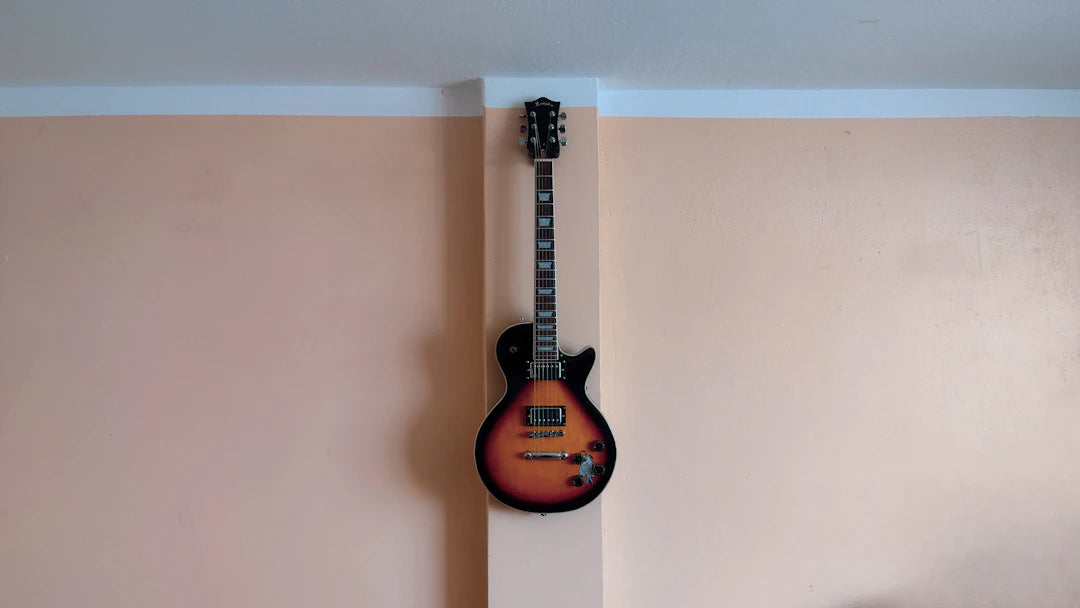Overview
Understanding color theory is crucial for electric guitar painting, as it affects aesthetics and emotional impact. Key aspects include primary, secondary, and tertiary colors, color harmony, and practical painting techniques. Customization allows musicians to express their identity through unique designs. The choice of paint and application methods are vital for durability and appearance. Lighting influences color perception, and balancing aesthetics with functionality enhances performance. Staying updated on trends while maintaining personal style can inspire creativity, making the painted guitar a true reflection of the artist.
Frequently Asked Questions
1. What is the role of color theory in electric guitar painting?
2. What are primary colors, and why are they important in guitar painting?
3. How can colors evoke emotions in electric guitar refinishing?
4. What are some practical aspects to consider when painting a guitar?
5. How can musicians customize their guitars to reflect their personal style?
When it comes to creating a unique electric guitar, the final layer of paint can make all the difference. While premium guitar pickups resonate with sound quality, the color of a guitar can evoke emotion and reflect personal style. Understanding color theory is essential to achieving an eye-catching finish that not only appeals visually but also enhances the overall experience of playing. In this article, we’ll explore the role of color theory in guitar painting and how it can transform a simple instrument into a masterpiece.
Understanding Color Theory
Color theory is a complex system of visual principles that explains how colors interact with one another. At its core, color theory can be broken down into three main categories: primary, secondary, and tertiary colors. Understanding these categories and their relationships can empower artists and guitar refinishing professionals to make informed decisions when choosing the perfect color scheme for a guitar.
Primary Colors: The Foundation of Your Palette
Primary colors are the building blocks of all other colors. These include red, blue, and yellow. By experimenting with these colors, guitar painters can create numerous combinations. Characteristic of electric guitars, bold and bright shades often draw attention.
Secondary and Tertiary Colors: Expanding the Spectrum
When you mix primary colors, you get secondary colors: green, orange, and purple. Tertiary colors arise from mixing a primary color with a secondary color, creating a broader palette. This expanded color selection allows for incredible customization and expression. For instance, creating a custom guitar finish might involve using a base of teal with yellow highlights or deep mauve with hints of burnt orange, showcasing the artist’s unique vision.
The Emotional Impact of Color
Colors evoke emotions and influence perceptions. In the world of electric guitar refinishing in Austin, it’s imperative to understand how colors can convey strong feelings and associations. For example:
- Red: Symbolizing passion and energy, red can create an intense and bold aesthetic, perfect for rock music enthusiasts.
- Blue: An embodiment of tranquility and stability, blue hues can appeal to jazz and blues musicians.
- Yellow: Bright and cheerful, yellow can instill joy and positivity. This color is ideal for an upbeat music style.
- Green: Associated with nature and growth, greens can provide a sense of calm and creativity.
- Black: Often linked with sophistication, mystery, and elegance, a black-finished guitar can showcase a professional appearance.
- White: Symbolizing purity and simplicity, white guitars can provide a clean and classic look.
Choosing the right color to match the music genre and the player’s personality is essential for anyone seeking electric guitar refinishing in Austin or any professional guitar painter.
Color Harmony: Creating Visual Balance
Color harmony refers to the pleasing arrangement of colors that work well together. Some common color schemes include complementary, analogous, and triadic colors. Understanding these relationships can significantly enhance the aesthetic appeal of a painted guitar.
Complementary Colors
Complementary colors are located opposite each other on the color wheel, such as blue and orange or red and green. When used thoughtfully, complementary colors can create striking contrasts that attract the eye, making the guitar stand out. For example, a maroon base with bright teal accents can create a breathtaking effect for the audience while playing on stage.
Analogous Colors
Analogous colors sit next to each other on the color wheel. These hues share a common color and provide a more subtle and harmonious visual effect. An example of an analogous color scheme for a guitar could be blue, blue-green, and green. This combination can evoke feelings of serenity and connection to nature, resonating with acoustic or jazz players.
Triadic Colors
Triadic colors consist of three colors evenly spaced on the color wheel. This scheme provides balance and vibrancy. An example could include red, yellow, and blue. A guitar painted in this style could become a standout piece with equal attention drawn to each of its hues, making it suitable for musicians looking to express a vivid personality.
The Practical Side of Guitar Painting
While color theory is essential for aesthetic appeal, practicality in the painting process is equally important. The types of paint used can significantly impact the final result, as well as the guitar's performance. Here are some practical aspects to consider:
Types of Paint
Choosing the right type of paint is crucial for durability and visual appeal. Common options include:
- Acrylic Paint: Lightweight and readily available, acrylic paints are user-friendly and work well for various projects, including electric guitar refinishing.
- Enamel Paint: Known for its durability and glossy finish, enamel paint provides a professional look and feel, ideal for stunning guitar finishes.
- Spray Paint: Offering even coverage and a range of colors, spray paint is a great option for quick and smooth finishes.
Application Techniques
Applying paint requires practice and technique. Whether using spray paint or brushing it on, achieving the desired finish involves ensuring even coverage, avoiding drips, and allowing for ample drying time between coats. Painters might choose to layer colors for more depth or use stencils for intricate designs.
The Allure of Customization
Customization is a significant trend in the guitar-playing community. Musicians understand that their guitars are an extension of their identity. Whether it’s through the paint job or the quality of premium guitar pickups, personal touch is paramount. A unique finish can turn a standard instrument into a conversation starter on stage.
Incorporating Graphics and Artwork
For those artists looking to make an impact, incorporating graphics, patterns, or even personal artwork can further express individuality. Custom illustrations or decals can serve as a beautiful complement to the choice of color, creating a cohesive look that stands out. Musicians can opt for intricate designs, simple geometric patterns, or even personal messages that contribute to their story.
The Impact of Lighting on Color Perception
One often-overlooked aspect of color theory in guitar painting is the influence of lighting on how colors are perceived. Natural light can bring out the depth and vibrancy of a paint job, while artificial lighting can sometimes alter its appearance. When choosing colors for an electric guitar refinishing project, it’s important to consider how the finished instrument will look in different settings, whether on stage, in the studio, or during jam sessions with friends.
Balancing Color with Functionality
While aesthetics play a critical role in selecting the right color and finish for a guitar, functionality should never be neglected. A well-painted guitar must not only be visually appealing but should also provide optimal performance. Quality paint finishes can help protect the wood from damage and enhance the guitar's sound quality. When paired with premium guitar pickups, a well-finished instrument can strike the perfect balance between beauty and functionality.
Incorporating Trends while Staying True to Style
The world of guitar painting is constantly evolving, with new trends emerging regularly. Whether it’s a nod to vintage aesthetics or a leap towards modern minimalism, staying informed about current trends can inspire guitarists to explore fresh designs. However, it’s essential to blend these trends with individual style. For example, a vintage-style guitar with a contemporary color scheme can reflect both personal taste and modern influences.
Unveiling Creativity through Collaboration
For aspiring guitar painters or refinishers, collaboration can spark new ideas. Whether teaming up with fellow musicians, artists, or professional painters, brainstorming sessions can lead to unexpected and creative outcomes. Collaboration fosters innovation and results in unique finishes that might not have been conceived through individual efforts.
Your Unique From Every Angle
To summarize, color theory plays an essential role in the guitar painting process, providing a framework for artists to express themselves through vibrant and unique designs. From understanding primary, secondary, and tertiary colors to perfecting color harmony and application techniques, the painter holds the power to create an instrument that reflects both the player’s personality and the essence of their music. So grab your brushes, choose your colors, and embark on a journey of creativity. With the right approach, your painted guitar can become not just an instrument, but a representation of your artistic soul!
Linked Product

Odyssey Solstice Tele Neck SC
The Odyssey Solstice Tele Neck SC pickup is designed to deliver a warm and articulate tone, making it suitable for genres like country, blues, and Americana. Crafted with precision in the USA, its hand-wound construction and Alnico V magnets enhance harmonic complexity while ensuring reliable performance. This pickup is a solid choice for musicians seeking the classic Telecaster sound with modern consistency.
View ProductVisit the Shopify or Wix store of a fellow user by following this link to their store. Please note that this is a promotional link, and we are not responsible for the content of the linked store.











